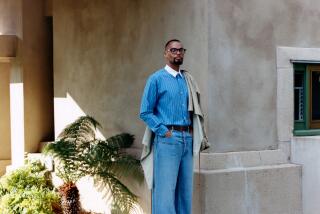Letters on Cezanne : <i> by Rainer Maria Rilke (Fromm International: $12.95; 98 pp.)</i>
- Share via
If there are any young couples left who believe in poverty and great art, they are liable to exchange this little book at the holidays. Rainer Maria Rilke’s “Letters on Cezanne” distills the very nectar from the romance of humble beginnings and noble aspirations.
In 1907 the 31-year-old Czech-Austrian poet was living in Paris. He had just spent a year as secretary to Auguste Rodin and was about to encounter Paul Cezanne’s art in the Autumn Salon exhibition at the Grand Palais a year after the artist’s death. Rilke was so taken with the “Hermit of Aix” that he wrote a series of letters on him home to his wife Clara. They make up this precious 98-page book.
At the beginning of Modernism there was a special bond between poets and artists. They shared a basic task of using their gifts to evoke the essence of experience through condensation. They also shared the need to see their metier as a passionate, virtually religious dedication where one was required to succeed only through the art itself, even if that meant sacrificing every other human comfort or reward. This led to an art whose very content was the spiritual struggle required to make the art.
Rilke had doubts about his own commitment, but he found an ideal in Cezanne, who was admired for trudging back and forth to his isolated studio even under the assault of old age and children literally throwing rocks at him as he came and went. Rilke revered Cezanne’s “limitless objectivity” and the labor of his paintings, which “no longer knew any preferences or biases or fastidious predilections, whose minutest component had been tested on the scales of an infinitely responsive conscience.”
The letters are also testament to a poet’s capacity to turn ordinary life into an encrusted odyssey of significant event. Rilke writes of the muffled misery of Paris’ gray, rainy fall, his absolute joy in discovering a portfolio of Vincent Van Gogh reproductions, the poignancy of walking past rich, gated houses and sensing the presence of other lives. A pair of pomegranates makes him ecstatic.
“How glorious they are in their massive heaviness with the curved ornament of the pistil still on top; princely in their golden skin with the red undercoat showing through, strong and genuine like the leather of old Cordovan tapestries.”
Part of the pleasure of the book is recognizing that Rilke was beginning to build a Cezanne-like art in words even as he wrote of doubting his ability to do so. His earnestness is endearing, but it will not sustain even so much contradiction as a cynically cocked eyebrow. The guy was heartfelt to the point of self-caricature. Accepted on those terms, however, the book rewards us with the kind of rare insight of such classics as Paul Klee’s “Pedagogical Sketchbook” or Gertrude Stein’s “Autobiography of Alice B. Toklas.” Whatever else each is up to, they whisper truth about the obdurate enthrallment of being an artist.
More to Read
Sign up for our Book Club newsletter
Get the latest news, events and more from the Los Angeles Times Book Club, and help us get L.A. reading and talking.
You may occasionally receive promotional content from the Los Angeles Times.










